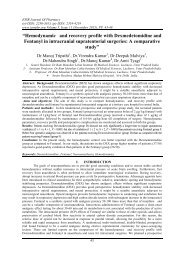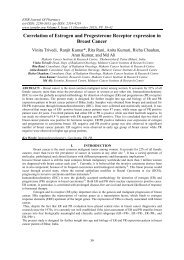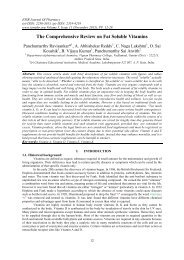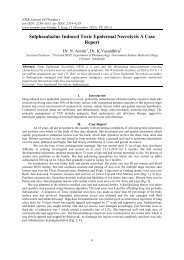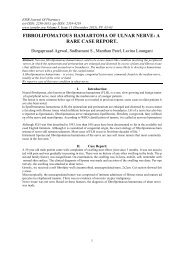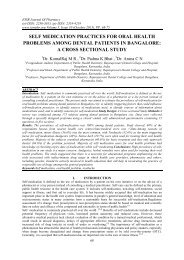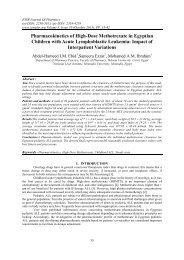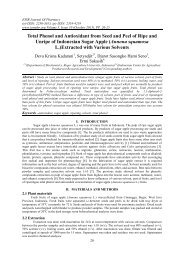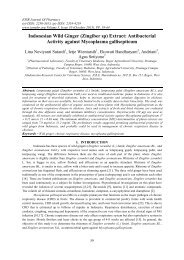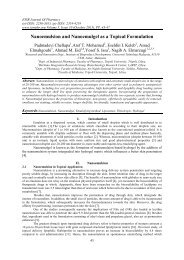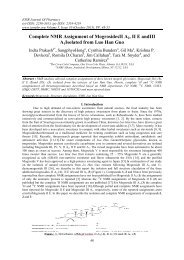Clinical manifestations, diagnosis,and treatment of Melioidosis
Create successful ePaper yourself
Turn your PDF publications into a flip-book with our unique Google optimized e-Paper software.
<strong>Clinical</strong> <strong>manifestations</strong>, <strong>diagnosis</strong>…<br />
Singapore [26-28].Other countries in the region where melioidosis is recognized in human <strong>and</strong> animals include<br />
China(especially Hong Kong), Taiwan,Brunei,Veitnam, <strong>and</strong> Laos[29-33].<strong>Melioidosis</strong> is also likely to occur in<br />
Cambodia <strong>and</strong> Philippines [21,25,34].<strong>Melioidosis</strong> has been increasingly recognized in India, although reports<br />
that some <strong>of</strong> the ―Plague‖ scares <strong>of</strong> 1994 may have been cases <strong>of</strong> melioidosis have been disapproved[35-<br />
36].Cases have been reported from Sri Lanka,Bangladesh,<strong>and</strong> Pakistan[21].Despite the early documentation <strong>of</strong><br />
melioidosis in Burma <strong>and</strong> Indonesia,recent cases had not been reported from Indonesia until after Asian<br />
tsunami[37].Cases <strong>of</strong> melioidosis have also been documented from Papua New Guinea,Fiji,<strong>and</strong> New<br />
Caledonia,but the extent <strong>of</strong> the indemnity in the Pacific isl<strong>and</strong>s remains to be defined[38].<strong>Melioidosis</strong> cases are<br />
increasingly being documented from outside the classic endemic region <strong>of</strong> Southeast Asia,Australasia,the Indian<br />
subcontinent, <strong>and</strong> China.These include sporadic human or animal cases or environmental isolates <strong>of</strong><br />
B.pseudomallei from Middle East,Africa,the carribean,<strong>and</strong> Central <strong>and</strong> South America. Although some <strong>of</strong> these<br />
reports are from incorrect species <strong>diagnosis</strong>, other are confirmed making the endemic limitations <strong>of</strong> melioidosis<br />
very unclear[21]Sporadic cases <strong>and</strong> occasional case clusters have recently occurred in Brazil <strong>and</strong> elsewhere in<br />
America[39].Despite recent cases from Madgascar,the true extent <strong>and</strong> magnitude <strong>of</strong> the presence <strong>of</strong><br />
B.pseudomallei in Africa remains entirely unknown[40].Global warming may well result in expansion <strong>of</strong><br />
endemic boundaries <strong>of</strong> melioidosis [41].<br />
The two locations where melioidosis is arguably the most important single bacterial pathogen for humans are<br />
northeast province in Thail<strong>and</strong> <strong>and</strong> the Top End <strong>of</strong> the Northern Territory <strong>of</strong> Australia. In northeast<br />
Thail<strong>and</strong>,20% <strong>of</strong> community- acquired septicemic cases are caused by melioidosis,which accounts for 39% <strong>of</strong><br />
fatal septicemias <strong>and</strong> 36% <strong>of</strong> fatal community acquired pneumonias[23,31].In the Top End <strong>of</strong> Northern<br />
Territory,melioidosis has been the most common cause <strong>of</strong> fatal community-acquired bacteremic pneumonia[42].<br />
In addition to endemic melioidosis,there are several documented situations where melioidosis became<br />
established in nontropical locations. In France, in the 1970s animals in a Paris Zoo,with spread to other Zoos<br />
<strong>and</strong> equestrian clubs[19]. In addition to fatal animal <strong>and</strong> human cases, there was extensive soil contamination<br />
persisting for some years.B.pseudomallei was considered likely to have been introduced by importation <strong>of</strong><br />
infected animals.A cluster <strong>of</strong> cases occurred over 25- year period in southwestern Westren<br />
Australia(31 o .S),involving animal cases <strong>and</strong> one human infection in a farmer. Ribotyping <strong>of</strong> farm animal <strong>and</strong><br />
human isolates <strong>and</strong> one isolate from the soil showed identical patterns [43]This supports the suggestion <strong>of</strong> clonal<br />
introduction <strong>of</strong> B.pseudomallei into this this temperate region,probably via infected animal, with environmental<br />
contamination,local dissemination <strong>and</strong> persistence over 25 years[41]. .<br />
III. PATHOGENESIS<br />
Worldwide studies have shown that most infection with B.pseudomallei is asymptomatic [44]. In<br />
northeast Thail<strong>and</strong>, most <strong>of</strong> the rural population is seropositive by indirect hemaggultination(IHA),with most<br />
seroconversion occurring between 6 months <strong>and</strong> 4 years <strong>of</strong> age[45]. Although the melioidosis occurring in all<br />
age groups, severe clinical disease such as septicemic pneumonia is seen mostly in those with risk factors such<br />
as diabetes, renal disease, <strong>and</strong> alcoholism[44]. In addition to infection by inhalation, bacterial load on exposure<br />
(inoculating dose) <strong>and</strong> virulence <strong>of</strong> the infecting strain <strong>of</strong> B.pseudomallei are also likely to influence the severity<br />
<strong>of</strong> disease. However, it has been noted that despite the large bacterial load in severely ill patients with<br />
septicemic pulmonary melioidosis, person-to-person transmission is extremely unusual. This together with rarity<br />
<strong>of</strong> fulminant melioidosis in healthy people, supports the primary importance <strong>of</strong> host risk factors for development<br />
<strong>of</strong> melioidosis. Furthermore, although it is clear from laboratory studies <strong>of</strong> isolates <strong>of</strong> B.pseudomallei from<br />
animals, humans, <strong>and</strong> the environment that virulence differs among B.pseudomallei isolates[46].the importance<br />
<strong>of</strong> this variation in virulence in determining clinical aspects <strong>of</strong> melioidosis remain unclear. Molecular typing that<br />
shows clonality <strong>of</strong> isolates in animal <strong>and</strong> human clusters has revealed that same outbreak strain can cause<br />
different clinical presentations, with host factors being most important in determining the severity <strong>of</strong> disease<br />
[47].Whole genome sequencing <strong>and</strong> subsequent molecular studies have shown that B.pseudomallei has two<br />
chrosomes, multiple genomic isl<strong>and</strong>s that are variably present in different strains <strong>and</strong> have a great propensity for<br />
horizontal gene transfer[48].Further studies are required to unravel the global phylogeny <strong>and</strong> evolutionary<br />
history <strong>of</strong> B. psedumallei <strong>and</strong> related species <strong>and</strong> to determine which genes or gene clusters may be critical for<br />
pathogenesis <strong>and</strong> disease presentation <strong>and</strong> outcome [49]. B.pseudomallei is a facultative intracellular pathogen<br />
that can invade <strong>and</strong> replicate inside various cells, including polymorphonuclear leukocytes <strong>and</strong> macrophages<br />
<strong>and</strong> some epithelial cells[50].Animal models have been unable to confirm a clinically relevant exotoxin for<br />
B.pseudomallei[51].However resistance to human serum (conferred by lipopolysaccharide[LPS])[52],<strong>and</strong> the<br />
ability <strong>of</strong> B.pseudomallei to survive intracellularly (conferred in part by capsular polysaccharide) appear to be<br />
critical in the pathogenesis <strong>of</strong> melioidosis[53-55].Type III secretion system in B.pseudomallei have also been<br />
found to be important in cell invasion <strong>and</strong> intracellular survival[56-57].<br />
14




